From Virginia to Hungary, Michigan, Pennsylvania and Delaware — four Eastern Mennonite University students were accepted into the National Science Foundation’s highly competitive Research Experience for Undergraduate (REU) program. Seniors Eli Wenger, Hannah Daley and Janaya Sachs and junior Amanda Williams spent their summer immersed in research projects — investigating zooplankton, measuring light in forests, and exploring photocatalysts.
Their varied experiences confirmed both a thirst to continue learning and a conviction that they are ready for the rigors of graduate research. After years of laboring to learn foundational knowledge, the roughly 10-12-week experience also symbolized a significant portal.
“We work hard for so long in the sciences to just get to the threshold of where knowledge is produced,” said Wenger, a senior biochemistry major. “In the first couple of weeks, there were times when I would ask my mentor ‘Why is this happening?’ or ‘Why isn’t this happening?’ and they would say, ‘We don’t know, but let’s keep working and maybe we’ll be the ones to figure it out. …It was tremendously exciting to be at the boundary of knowledge and ignorance, in a place where we were part of knowledge being produced.”
“Research and internship experiences build students marketable skills and give them a broader understanding of jobs and graduate school options upon graduation,” said biology and chemistry department chair Tara Kishbaugh, adding the REUs are one example of a host of similar summer opportunities that EMU students are involved in.
All biology and chemistry students are required to complete research as part of their degree, she said, with some form of research, “or least open-ended, question-driven projects being part of the EMU curriculum as early as General Chemistry II.”
Students who have taken the research seminar, a methods and philosophy course, and/or who have already worked with an EMU faculty on a research project are more competitive for these summer programs, Kishbaugh said.
Prospective participants apply directly to REU-funded sites in 19 research fields. Sometimes as many as 200 students apply for 10 or fewer positions. Wenger suggests applying to as many REUs as possible: “as many as you can stand,” he says, adding that the application differs for each site.
“Don’t be afraid to explore an area that you are new to,” added Williams.
Hannah Daley • atmospheric chemistry • University of Michigan Biological Station
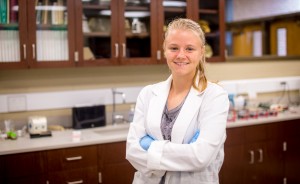
What she studied: My research topic was light penetration and nitrogen dioxide photochemistry under different forest canopies in northern Michigan. Nitrogen dioxide, when broken down by light into highly reactive compounds, contributes to the creation of photochemical smog. Because air pollution travels, what happens when a gust of NO2 –heavy city air gets blown into the neighboring forest? Does NO2 have enough available light to break down or does it remain as NO2 throughout the forest?
Supporting skills: To do my research, I first built a remote power supply with six car batteries (weighing about 200 pounds) to power four sensor sites under different canopy covers, such as pine, aspen, maple/beech/oak, and mixed). [Daley shared that one of her professor-supervisors quipped, “We do standard carpentry, HVAC, electrical work, vehicle mechanics and plumbing, and occasionally we do some science.”]
I mostly worked alone before sunrise and after sunset, because my data was collecting at daylight times. After getting up at 4:30 a.m., I biked to my sensor sites between .5 and 3 miles away. I then analyzed data. Between 9-11 p.m. every night, I would move and turn off sensors to conserve my remote power supply.
Connections: Though the REU was based at the University of Michigan Biological Station, my mentors were collaborating professors Dr. Will Wallace and Dr. Rob Griffin from Rice University and Dr. James Flynn from the University of Houston. The biological station hosted an atmospheric chemistry field campaign known as PROPHET. I met about 18 atmospheric chemistry research groups from top institutions, like Harvard, University of Colorado-Boulder and Cal Tech.
Advice to fellow students: ‘Do it!’: This was my second REU [last year, Hannah was at James Madison University] and I loved both experiences. When you go to a small school, it is hard to know the variety and depth of research possibilities available. REUs open a door to more than just hands-on experience. They provide networking opportunities and a place to advance your professional development. I’ll continue to analyze the data I collected this following fall and present it as my Honors capstone project.
Janaya Sachs • chemistry • ELTE University, Budapest, Hungary
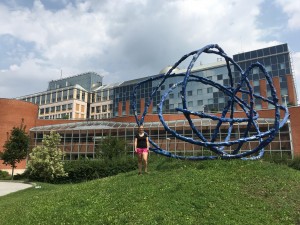
What she studied: My summer research involved exploring copper photocatalysts and the process involved in synthesizing them. Copper photocatalysts are more common and inexpensive than iridium and ruthenium, which are typically used.
Living in Budapest: My day in Budapest started with taking public transit to the university. I worked in a lab I shared with an REU student from James Madison University; with Hungarian graduate students; and advisors Dr. Timothy Peelen from Lebanon Valley College and Dr. Zoltan Novak, from ELTE. Depending on where I was in a reaction, my day would include normally a mix of finding and reading journal articles for ideas and procedures, starting a reaction, characterizing it, and working it up to retrieve what I hoped would be the product from the reaction.
Highlights
- Being exposed to the international world of chemistry research, its collaborative nature and funding networks.
- Learning how to stretch resources when funding is low. This is in contrast to my REU last summer at the University of Minnesota where I had resources always at my disposal. The Hungarians had to learn how to characterize reactions without always using an NMR, the standard characterization method in the United States. We also washed and reused our pipets and vials, greatly decreasing glass waste, and when it came time to wash these, we first rinsed with distilled waste acetone allowing for multiple uses of acetone (in the States, acetone is disposed of after every washing). These and many other techniques used when a chemistry research group has to stretch their funding was a very educational experience.
- I also enjoyed how comfortable I was navigating a foreign city for a whole summer. Thanks to everything I’ve learned through the EMU chemistry department and my previous REU experience as well as through my cross-cultural, I felt very ready and capable living and doing science abroad. I am also prepared to work across language barriers and cultural barriers with other chemists in a way I was not before this experience.
Eli Wenger • chemistry • Pennsylvania State University
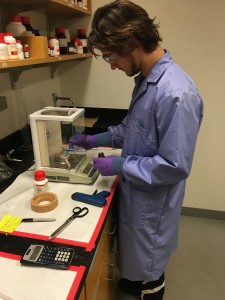
What he studied
This research was in the field of synthetic inorganic nanochemistry, the chemistry of materials that can be used in industrial applications. Currently, water is split into hydrogen and oxygen gas to make fuel, but the only electrodes that can handle that chemistry is made of expensive metals like platinum or irridium. The objective of this research, supervised by Dr. Raymond Schaak, was to engineer new, inexpensive and earth-abundant materials to use as electrodes in water-splitting reactions to create fuel. If successful, this could potentially transform the energy economy.
Highlights
- We don’t have inorganic chemistry here at EMU, so this was a whole new field to me. That was pretty exciting … One day I was making copper-palladium alloy particles and they ended up hollow; none of us could say how or why. My mentor, a postdoctoral student, said she was going to keep working on that.
- The other REU students were a fun group, and the graduate students in the lab were very helpful. There was a really positive atmosphere to the lab. There is a misconception that the science lab is an isolated place, but it’s very interactive and feels like a team. There were 25 of us crammed into this lab and when something interesting happened, you’d go check it out.
- This experience was like living 10 weeks as a graduate student before I started a grad program. I was able to work in a lab and build connections with graduate students, administrative staff, professors and, most critically, admissions staff. I sat in on a number of doctoral defenses. We were exposed not just to academia but also to industry, through speakers and a tour of the DOW Chemical facility outside Philadelphia. This experience affirmed that I want to go to graduate school and that by the end of five years, I will have an idea of what was next for me professionally.
Amanda Williams • Marine biology • University of Delaware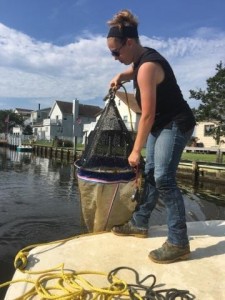
What she studied: My research under the supervision of Dr. Jonathan Cohen focused on collecting zooplankton from dead-end canals in South Bethany, Delaware, to determine if a recent bioremediation project, using floating wetlands and oyster gardens, was effective in positively changing the water quality and zooplankton biodiversity.
Every day was different: I went on several cruises of the Delaware Bay to help a graduate student collect zooplankton and plastic samples for her research project. Through the REU program, I re-certified my Delaware boating license, and attended weekly seminars presented by professors at the School of Marine Science and Policy. I also worked on my project, which included collecting zooplankton samples, scanning and processing, and performing statistical analyses on the results.
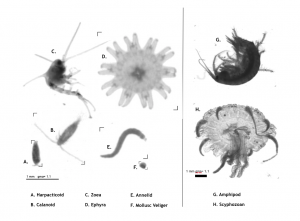
Highlights
- Working on a project that directly relates to a dream of mine, to help protect Delaware wetlands. Growing up on the Indian River, I hold the Delaware Inland Bays close to my heart, and knowing that I helped make a difference in one of these wetland areas is very gratifying.
- Using the rare ZooScan optical scanner, found in a few other universities throughout the country. This unique technology takes clear, high resolution images of tiny zooplankton.

